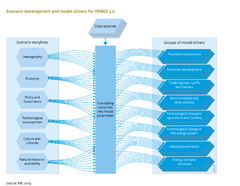Drivers/Scenario drivers: Difference between revisions
< Drivers
Jump to navigation
Jump to search
m (Text replace - "Agricultural systems" to "Land-use allocation") |
m (Text replace - "Nutrient balances" to "Nutrients") |
||
| Line 18: | Line 18: | ||
In addition to total number of people, the population is broken down into gender, income classes, urban and rural, and educational level. These attributes are relevant for issues such as consumption preferences and patterns, and access to goods and services. Using a downscaling procedure ([[Van Vuuren et al., 2007b]]), national and regional population can be projected at grid level to account for trends in urbanisation and migration within countries and regions. | In addition to total number of people, the population is broken down into gender, income classes, urban and rural, and educational level. These attributes are relevant for issues such as consumption preferences and patterns, and access to goods and services. Using a downscaling procedure ([[Van Vuuren et al., 2007b]]), national and regional population can be projected at grid level to account for trends in urbanisation and migration within countries and regions. | ||
Population data are used in energy and agricultural economics modelling, and in other IMAGE modules, such as [[Water|water stress]], [[ | Population data are used in energy and agricultural economics modelling, and in other IMAGE modules, such as [[Water|water stress]], [[Nutrients|nutrients]], [[Flood risks|flood risks]] and [[Human development|human health]]. | ||
===Policy and governance=== | ===Policy and governance=== | ||
Revision as of 09:16, 17 May 2014
Parts of Drivers/Scenario drivers
| Projects/Applications |
| Models/Databases |
| Relevant overviews |
| Key publications |
| References |
